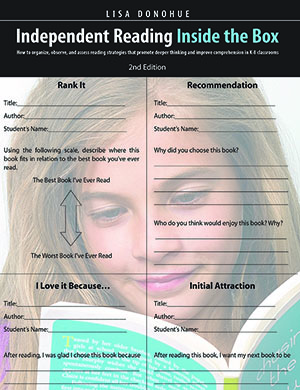| ________________
CM . . .
. Volume XXIII Number 19. . . .January 27, 2017
excerpt:
It was a pleasure to review the first edition of Independent Reading Inside the Box: How to Organize, Observe, and Assess Reading Strategies that Promote Deeper Thinking and Improve Comprehension in K-6 Classrooms by Lisa Donohue. For the first edition’s review, I praised the book’s practical approach and felt it was a valuable resource to teach balanced literacy. The basic tenant of the book is that students practice their reading skills during independent reading by completing reading activities in boxes on a template. Students complete one box for “My Reading” (book selection, goal setting, etc.), text elements, word skills, taxonomy of thinking, and four boxes about reading comprehension strategies. In this second edition, Donohue has made some slight changes and additions. First, she has renamed the independent reading template, known as Reading 8-Boxes in the first edition, to Reader Response Boxes. Since the publication of the first edition, Donohue has seen teachers use the boxes one at a time or used as prompts for reading and writing responses. While Donohue still sometimes uses the term Reading 8-Boxes in this new edition, the renaming of the 8-Boxes to Reader Response Boxes reflects the fact that the boxes are flexible and versatile, and all eight boxes do not have to be used simultaneously. Also new to this edition is the element of student choice. Donohue shows a photograph of a bulletin board where students can select which Reading Response Box they would like to complete for their reading activity that day. She also includes a new brief section entitled “Blended Learning” which discusses that technology can also be used to make the Reading Response Boxes digital. Chapter 5 in this new addition has been renamed “Thinking and Critical Literacy”, with a new section and Reader Response Box templates about critical literacy. In addition to the end of chapter assessment rubrics for each type of Reader Response Box (that were also present in the first edition), Donohue has added some assessment boxes for teachers to provide feedback to students. The new edition also includes a number of new Reader Response Boxes throughout as well as new student-completed examples. I do have some criticisms with two of the new additions to this second edition of Independent Reading Inside the Box. First, there is little to no detail or examples about how teachers can make the Reading Response Boxes digital. It would have been very helpful in this new edition to delve into this topic rather than only including a paragraph stating that it’s possible to make the strategy digital. Some student examples, recommended apps and software would be very helpful for classroom teachers. In addition, these could be included throughout each chapter rather than an isolated section. Second, I take issue with the fact that critical thinking is considered separate from Bloom’s taxonomy. In the original edition, Chapter 4 was called, “Box 4: Taxonomy of Thinking” and focussed on using the different levels of Bloom’s taxonomy in this section of the 8-Box template. In the new edition, Chapter 4 is entitled “Thinking and Critical Literacy” and has different sections and Reader Response Boxes for Bloom’s taxonomy and critical thinking. Why is critical thinking not included in the upper levels of Bloom’s taxonomy (such as evaluating)? While I absolutely appreciate the intent of including more critical thinking, I would suggest instead that Donohue demonstrate how critical thinking is incorporated into Bloom’s Taxonomy. By including it as a separate section, I am concerned that some teachers might view critical thinking as a separate construct without seeing the big picture of thinking skills. Independent Reading Inside the Box is not a second edition that is so different from the original that teachers would need to buy the new edition if they already owned the first. However, like the first edition, this second edition is a very useful and practical book and is one that I would still recommend. Recommended. Dr. Kristen Ferguson teaches literacy education at the Schulich School of Education at Nipissing University in North Bay, ON.
To comment
on this title or this review, send mail to cm@umanitoba.ca.
Copyright © the Manitoba Library Association. Reproduction for personal
use is permitted only if this copyright notice is maintained. Any
other reproduction is prohibited without permission.
Next Review | Table of Contents For This Issue - January 27, 2017 |
